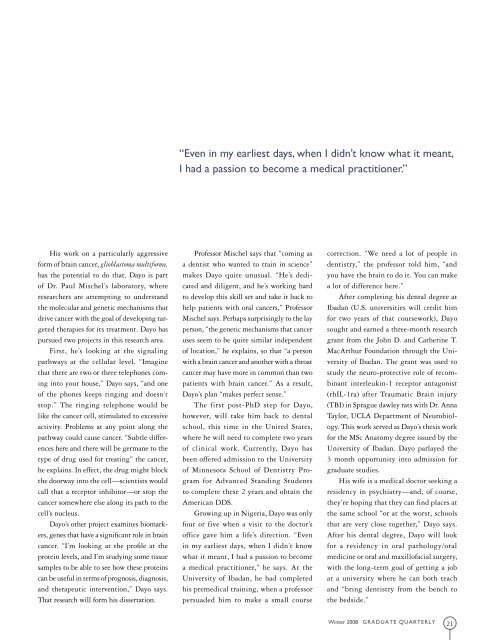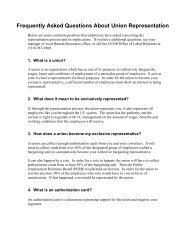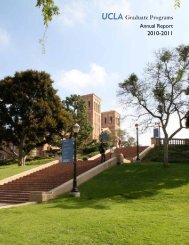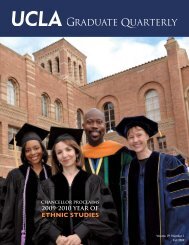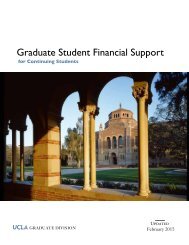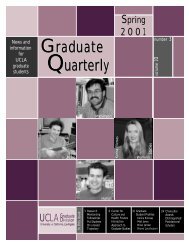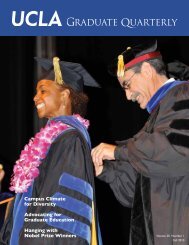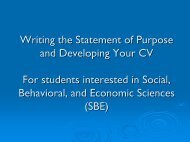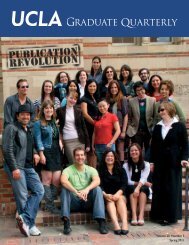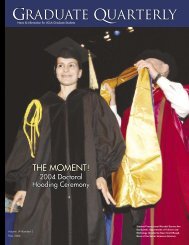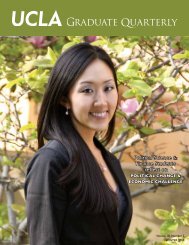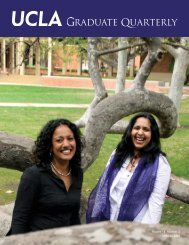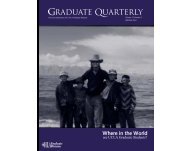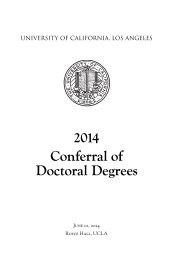Graduate Quarterly - Winter 2008 - UCLA Graduate Division
Graduate Quarterly - Winter 2008 - UCLA Graduate Division
Graduate Quarterly - Winter 2008 - UCLA Graduate Division
Create successful ePaper yourself
Turn your PDF publications into a flip-book with our unique Google optimized e-Paper software.
I had a passion to become a medical practitioner.”<br />
His work on a particularly aggressive<br />
form of brain cancer, glioblastoma multiforme,<br />
has the potential to do that. Dayo is part<br />
of Dr. Paul Mischel’s laboratory, where<br />
researchers are attempting to understand<br />
the molecular and genetic mechanisms that<br />
drive cancer with the goal of developing targeted<br />
therapies for its treatment. Dayo has<br />
pursued two projects in this research area.<br />
First, he’s looking at the signaling<br />
pathways at the cellular level. “Imagine<br />
that there are two or three telephones coming<br />
into your house,” Dayo says, “and one<br />
of the phones keeps ringing and doesn’t<br />
stop.” The ringing telephone would be<br />
like the cancer cell, stimulated to excessive<br />
activity. Problems at any point along the<br />
pathway could cause cancer. “Subtle differences<br />
here and there will be germane to the<br />
type of drug used for treating” the cancer,<br />
he explains. In effect, the drug might block<br />
the doorway into the cell—scientists would<br />
call that a receptor inhibitor—or stop the<br />
cancer somewhere else along its path to the<br />
cell’s nucleus.<br />
Dayo’s other project examines biomarkers,<br />
genes that have a significant role in brain<br />
cancer. “I’m looking at the profile at the<br />
protein levels, and I’m studying some tissue<br />
samples to be able to see how these proteins<br />
can be useful in terms of prognosis, diagnosis,<br />
and therapeutic intervention,” Dayo says.<br />
That research will form his dissertation.<br />
Professor Mischel says that “coming as<br />
a dentist who wanted to train in science”<br />
makes Dayo quite unusual. “He’s dedicated<br />
and diligent, and he’s working hard<br />
to develop this skill set and take it back to<br />
help patients with oral cancers,” Professor<br />
Mischel says. Perhaps surprisingly to the lay<br />
person, “the genetic mechanisms that cancer<br />
uses seem to be quite similar independent<br />
of location,” he explains, so that “a person<br />
with a brain cancer and another with a throat<br />
cancer may have more in common than two<br />
patients with brain cancer.” As a result,<br />
Dayo’s plan “makes perfect sense.”<br />
The first post-PhD step for Dayo,<br />
however, will take him back to dental<br />
school, this time in the United States,<br />
where he will need to complete two years<br />
of clinical work. Currently, Dayo has<br />
been offered admission to the University<br />
of Minnesota School of Dentistry Program<br />
for Advanced Standing Students<br />
to complete these 2 years and obtain the<br />
American DDS.<br />
Growing up in Nigeria, Dayo was only<br />
four or five when a visit to the doctor’s<br />
office gave him a life’s direction. “Even<br />
in my earliest days, when I didn’t know<br />
what it meant, I had a passion to become<br />
a medical practitioner,” he says. At the<br />
University of Ibadan, he had completed<br />
his premedical training, when a professor<br />
persuaded him to make a small course<br />
correction. “We need a lot of people in<br />
dentistry,” the professor told him, “and<br />
you have the brain to do it. You can make<br />
a lot of difference here.”<br />
After completing his dental degree at<br />
Ibadan (U.S. universities will credit him<br />
for two years of that coursework), Dayo<br />
sought and earned a three-month research<br />
grant from the John D. and Catherine T.<br />
MacArthur Foundation through the University<br />
of Ibadan. The grant was used to<br />
study the neuro-protective role of recombinant<br />
interleukin-1 receptor antagonist<br />
(rhIL-1ra) after Traumatic Brain injury<br />
(TBI) in Sprague dawley rats with Dr. Anna<br />
Taylor, <strong>UCLA</strong> Department of Neurobiology.<br />
This work served as Dayo’s thesis work<br />
for the MSc Anatomy degree issued by the<br />
University of Ibadan. Dayo parlayed the<br />
3 month opportunity into admission for<br />
graduate studies.<br />
His wife is a medical doctor seeking a<br />
residency in psychiatry—and, of course,<br />
they’re hoping that they can find places at<br />
the same school “or at the worst, schools<br />
that are very close together,” Dayo says.<br />
After his dental degree, Dayo will look<br />
for a residency in oral pathology/oral<br />
medicine or oral and maxillofacial surgery,<br />
with the long-term goal of getting a job<br />
at a university where he can both teach<br />
and “bring dentistry from the bench to<br />
the bedside.”<br />
<strong>Winter</strong> <strong>2008</strong> GRADUATE QUARTERLY<br />
21


